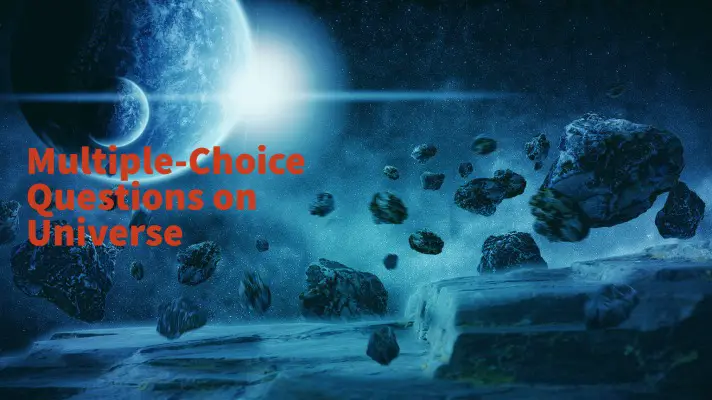Hello readers! I am going to discuss an interesting topic here. Who does not like to read and know more information about our Universe? The universe is everything that we can see and sense as well as those that we can’t see and sense. Here are a lot of Multiple-Choice Questions or Objective-Type Questions on the Universe.
If you want to collect this MCQ sheet in PDF Format, please click on the PDF Downloadable Button that is located at the bottom of this page.
Without wasting your time, let us start the MCQ Questions on the Universe.

MCQ Questions or Objective-Type Questions
Here are the Viva Questions on Universe:
- The universe is a/an:
- Empty space
- Filled space
- Star
- Both (i) and (ii)
Ans: (4)
- The stars are made of:
- Hot burning gas
- Dust
- Celestial objects
- Both (1) and (2)
Ans: (4)
- A galaxy is a collection of:
- Stars and Planets
- Gases
- Dust
- All of the above
Ans: (4)
- The other name of Milkyway Galaxy is:
- Akash Ganga
- Akash Yamuna
- Draco
- Ursha Major
Ans: (1)
- The sun appears brighter and bigger because:
- It is far away from our Earth
- It is biggest star in this Universe
- It is closer to the Earth
- None of the above
Ans: (3)
- Another name of the “Big Bear” constellation is:
- Ursha major
- Ursha large
- Orion major
- Draco major
Ans: (1)
- Big Bang is a huge
- Constellation
- Universe
- Explosion that creates the universe
- None of these
Ans: (3)
- The sun is a huge, glowing ball of:
- Hot gases
- Solid rocks
- Dust
- None of these
Ans: (1)
- Each planet moves around the sun in a fixed path. This path is called
- Axis
- Orbit
- Revolution
- Rotation
Ans: (2)
- The planet’s movement around the Sun is known as:
- Axis
- Orbit
- Revolution
- Rotation
Ans: (3)
- Which of the following have the light of their own?
- Mercury
- Sun
- Earth
- Mars
Ans: (2)
- Find the odd one:
- Sun
- Draco
- Orion
- Big bear
Ans: (1)
- The planet’s movement around its own axis is called:
- Axis
- Orbit
- Revolution
- Rotation
Ans: (4)
- The memory aids that help us to remember certain things, lists are called:
- Dwarf
- Mnemonics
- Menomics
- None of the above
Ans: (2)
- Natural satellite of Earth is:
- Sputnik
- Pluto
- Titan
- Moon
Ans: (4)
- The red planet is:
- Earth
- Venus
- Mars
- Mercury
Ans: (3)
- The closest planet to Sun is:
- Earth
- Venus
- Mars
- Mercury
Ans: (4)
- Mercury takes approximately _ days to complete one orbit around the sun.
- 365
- 356
- 88
- 66
Ans: (3)
- The brightest planet is:
- Earth
- Venus
- Mars
- Mercury
Ans: (2)
- Morning star/ evening star is:
- Earth
- Venus
- Mars
- Mercury
Ans: (2)
- The fifth largest planet is:
- Earth
- Venus
- Mars
- Mercury
Ans: (1)
- Blue Planet is:
- Earth
- Venus
- Mars
- Mercury
Ans: (1)
- Which of the following planet has faint rings?
- Neptune
- Jupitar
- Urenus
- Venus
Ans: (3)
- The largest planet in our solar galaxy is:
- Neptune
- Jupitar
- Urenus
- Venus
Ans: (2)
- Jupiter takes _ Earth years to complete one revolution around the sun.
- 1
- 6
- 12
- 18
Ans: (3)
- The second-largest planet in our solar system is:
- Neptune
- Jupitar
- Urenus
- Saturn
Ans: (4)
- The coldest planet in our solar system is:
- Neptune
- Jupitar
- Urenus
- Venus
Ans: (1)
- Who proved that the Earth is spherical and round?
- Ferdinand Magellan
- Galileo Galilee
- Copernicus
- None of these
Ans: (1)
- In which year it was proved that the Earth is round in shape?
- 1225
- 1522
- 1252
- 1555
Ans: (2)
- The flattened uppermost tip of the Earth is known as:
- North pole
- South pole
- East pole
- West pole
Ans: (1)
- The flattened lowermost tip of the Earth is known as:
- North pole
- South pole
- East pole
- West pole
Ans: (2)
- How much percentage of Earth’s surface is water?
- 30
- 50
- 70
- 90
Ans: (3)
- The necessary condition to support life is:
- Presence of water
- Suitable atmosphere
- Its right distance from the Sun
- All of the above
Ans: (4)
- Why is the atmosphere needed?
- To provide oxygen
- To provide air and water
- To block the harmful rays of the Sun from entering the Earth
- To block Carbon-Di-Oxide
Ans: (3)
- A black hole is a:
- Star with no atmosphere surrounded
- Pulsating star
- Contracted star having very dense gravitational pull
- None of these
Ans: (3)
- Which of the following property is indicated by the color of a star?
- Density
- Distance
- Size
- Temperature
Ans: (4)
- Which of the following planets have no natural satellites?
- Earth and Mars
- Uranus and Jupiter
- Earth and Saturn
- Mercury and Venus
Ans: (4)
Quiz Questions on Universe
Here are the quiz questions for you:
Conclusion
I hope that you have got a lot of new information from this article –“Multiple-Choice Questions or Objective Type Questions on Universe” and also you feel glad knowing our Universe. Please let me know how much you have liked this article by giving a comment. Your comment will encourage me in writing more articles.


